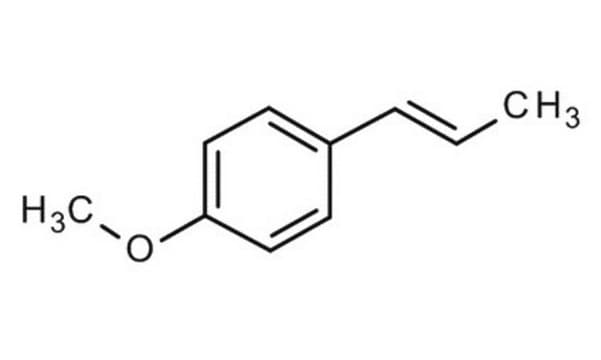W208620
Anethol
natural, 99%, FG
Sinónimos:
trans-Anethole, 4-Propenylanisole, trans-1-Methoxy-4-(1-propenyl)benzene
About This Item
Productos recomendados
grado
FG
Fragrance grade
Halal
Kosher
natural
Agency
follows IFRA guidelines
cumplimiento norm.
EU Regulation 1223/2009
EU Regulation 1334/2008 & 178/2002
FDA 21 CFR 117
Análisis
99%
composición
contains trans-Anethole
índice de refracción
n20/D 1.561 (lit.)
bp
234-237 °C (lit.)
mp
20-21 °C (lit.)
densidad
0.988 g/mL at 25 °C (lit.)
aplicaciones
flavors and fragrances
Documentación
see Safety & Documentation for available documents
alérgeno alimentario
no known allergens
alérgeno de la fragancia
trans-anethole
Organoléptico
anise; sweet
cadena SMILES
COc1ccc(\C=C\C)cc1
InChI
1S/C10H12O/c1-3-4-9-5-7-10(11-2)8-6-9/h3-8H,1-2H3/b4-3+
Clave InChI
RUVINXPYWBROJD-ONEGZZNKSA-N
¿Está buscando productos similares? Visita Guía de comparación de productos
Acciones bioquímicas o fisiológicas
Palabra de señalización
Warning
Frases de peligro
Consejos de prudencia
Clasificaciones de peligro
Aquatic Chronic 2 - Skin Sens. 1
Código de clase de almacenamiento
10 - Combustible liquids
Clase de riesgo para el agua (WGK)
WGK 2
Punto de inflamabilidad (°F)
213.8 °F
Punto de inflamabilidad (°C)
101 °C
Certificados de análisis (COA)
Busque Certificados de análisis (COA) introduciendo el número de lote del producto. Los números de lote se encuentran en la etiqueta del producto después de las palabras «Lot» o «Batch»
¿Ya tiene este producto?
Encuentre la documentación para los productos que ha comprado recientemente en la Biblioteca de documentos.
Los clientes también vieron
Nuestro equipo de científicos tiene experiencia en todas las áreas de investigación: Ciencias de la vida, Ciencia de los materiales, Síntesis química, Cromatografía, Analítica y muchas otras.
Póngase en contacto con el Servicio técnico









